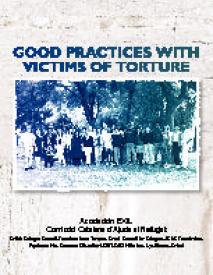Good practices with victims of torture
Introduction and support from the European Commission According to the United Nations Convention against Torture and Other Cruel, Inhuman or Degrading Treatment or Punishment, the term «torture» is any act by which severe pain or suffering, whether physical or mental, is intentionally inflicted on a person for such purposes as obtaining from him or a third person information or a confession, punishing him for an act he or a third
person has committed or is suspected of having committed, or intimidating or coercing him or a third person, or for any reason based on discrimination of any kind, when such pain or suffering is inflicted by or at the instigation of or with the consent or acquiescence of a public official or other person acting in an official capacity.
In the modern political and economic context, the use of force against humans has changed substantially compared with the period when these classical definitions were made. In some countries, the police and the army no longer have control over the population, and many different kinds of local “militia” and armed groups can exercise violence freely. Thus, it has become more and more common that torture is not exercised by the authorities but facilitated by their weakness.
Geachte bezoeker,
De informatie die u nu opvraagt, kan door psychotraumanet niet aan u worden getoond. Dit kan verschillende redenen hebben,
waarvan (bescherming van het) auteursrecht de meeste voorkomende is. Wanneer het mogelijk is om u door te verwijzen naar de bron
van deze informatie, dan ziet u hier onder een link naar die plek.
Als er geen link staat, kunt u contact opnemen met de bibliotheek,
die u verder op weg kan helpen.
Met vriendelijke groet,
Het psychotraumanet-team.
42 p. | Barcelona : Asociación EXIL Comissió Catalana d’Ajuda al Refugiat
https://www.ccar.cat/wp-content/uploads/2016/04/good_practices_with_victims_of_torture.pdf


